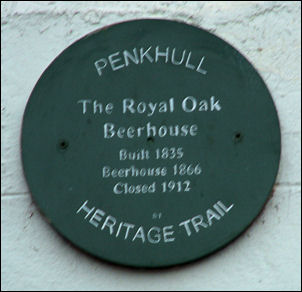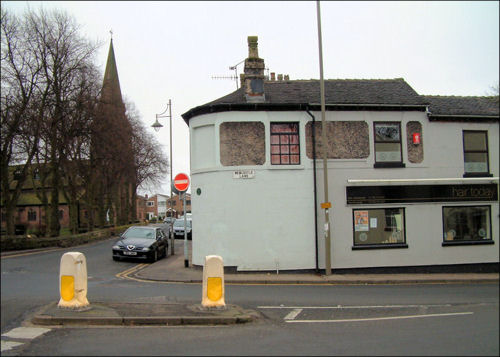|
The Royal Oak, Penkhull
  
click the
"contents" button to get back to the main index & map
next: The Queen's
Head, Tunstall
previous: The
American, Cobridge
|
Historian Fred Hughes
writes....
The
technique of hairdressing is historically a deep-rooted trade, if you’ll
pardon the pun. A five-shilling perm or a home twinset went out with
ponytails and empire in the 1950’s. Since then the job of the stylist has
become highly skilled and inventive. Hair extension is even more complex
though. They tell me that assembling a person’s crowning glory to make it
thicker and longer requires artistry, and in some cases a magic touch.
“The
reason I’m having hair extensions is because I want to grow my hair long,”
says Longton car service manager Becky Springett. “The extensions will let
me get used to the length and if I like it I’ll keep it long.”
Becky is
having extensions done at Arlene Taylor’s chicly-named Hair Today salon in
Penkhull.
“I’ve run
the business from this shop with my sister-in-law Linda Edwards for five
years,” Arlene tells me, deftly fixing a wispy length of blonde extension
glued by Linda to Becky’s scalp.
|
I
wondered whether they knew what the shop was used for in the old days.
“I’ve
always thought it was a hairdresser’s,” says Linda. “As long as I’ve
known it there’s been a hairdresser on two floors here.”
I point
out that it was once a pub. The three women pause in their joint labour to
consider this.
“I’d
never have thought of it as a pub,” says Arlene. “How do you know?”
There’s a
plaque on the wall outside, I say. The women are surprised, they’d never
noticed it.

“The
salon is part of a small row of cottages built in 1835,” historian Steve
Birks recalls. “They lined up in a row of eight but the two end ones
were converted into the Royal Oak later. The only clue is the plaque on
the wall and a memorial in St Thomas’s churchyard across the road
dedicated to a previous licensee Mary Ann Shenton who died in 1884,
otherwise you’d never guess it had been a pub.”
|

Previously the
Royal Oak, Penkhull
To dig
further into these times I ask Penkhull historian Richard Talbot to lend a
hand.
“I have
a personal interest in the building because a direct ancestor of mine
actually kept the pub,” he says. “The date of the conversion was
probably when the cottages were purchased by a landlord named John
Royal. The 1861 census first mentions its name – the Royal Oak and
describes the owner as a chap named George Henry Underwood, a
beer-seller. George was married to Eliza of Stoke and had four children
the youngest of whom was James, my great-grandfather. James’s daughter,
my grandmother Eliza-Ann, married Thomas Talbot. His profession is later
listed also as a beer-seller.”
The
profession beer-seller became recognised in the reign of William IV and
was used in reference to the Beerhouse Act 1830 designed to wean the
public off ‘mother’s ruin’ a nickname for gin. Its habit-forming
consumption had, by the late Georgian period, reached epidemic proportions
as a cheap but poisonous concoction. Pubs often displayed the sign ‘Drunk
for a penny, dead drunk for twopence, clean straw for nothing.’ Gin was a
narcotic for abject poverty. One contemporary social reformer declared
there were only two means of enjoyment for the poor – sex and alcohol. And
drunkenness was by far the more attractive of the two as it was cheaper
and its effects more fulfilling.
“The
beer act allowed anyone to brew and sell beer even from their own homes
simply by paying an annual licence fee of £2,” explains Richard. “Its
convenience had some effect on gin consumption but its main purpose was
to increase excise revenue. Thousands of beer-houses opened throughout
the country. In Stoke-on-Trent alone hundreds of new pubs were literally
created overnight. There are still a handful remaining but their times
had really come to an end by the 1970’s.”
|
In
tribute to this early piece of social legislation many pubs were named
after the legislators.
“King
William IV and the Duke of Wellington were popular names,” says Steve.
“Later the Marquis of Granby set up pubs for his retired and disabled
soldiers. Almost every town had a pub named after the Marquis. Many of
these tiny beer-houses were taken over by fast-developing local breweries
such as Parkers of Burslem.” |
Meanwhile
Penkhull’s Royal Oak was changing hands often.
“In 1860
a landlord named William Bridgwood took it over from the tenant who was in
default of his mortgage,” says Richard. “In 1870 it was in the hands of
William Benbow who sold it to a William Bradbury for £525. Then in 1884
the Shenton family owned it.”
Richard’s
investigations are comprehensive with a list of previous landlords almost
as long as his arm.
“By 1901 the house has ceased being used as a pub and was turned into a
grocery shop,” he says. “In 1912 it was redeveloped into as a quality
business by Albert Swetnam who changed the interior in a massive
conversion. It remained a successful Swetnam’s grocery until 1955 when it
was called the Village Stores owned by J Brunt. Now it’s a hairdresser’s;
whatever next?”
  
click the
"contents" button to get back to the main index & map
next: The Queen's
Head, Tunstall
previous: The
American, Cobridge |